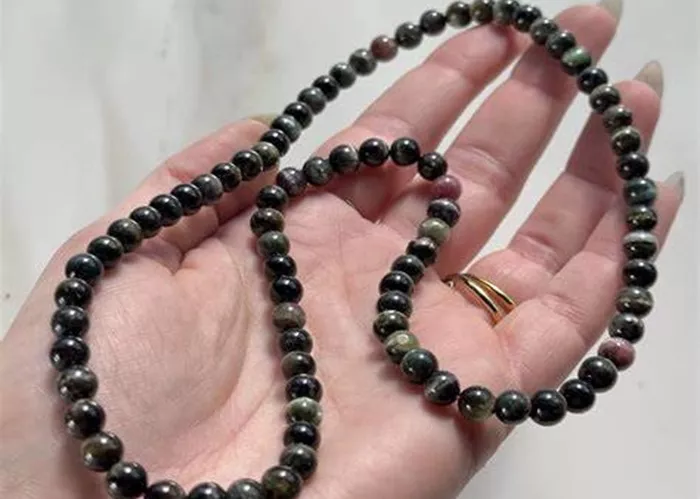Cat’s-eye tourmaline is a rare and captivating gemstone prized in the jewelry world for its unique optical effect known as chatoyancy. This effect creates a luminous band of light that resembles the slit eye of a cat, giving the gem its name. As a member of the tourmaline family, this gem combines beauty, rarity, and intriguing physical properties, making it highly sought after by collectors and jewelry enthusiasts.
Tourmaline itself is a complex silicate mineral that comes in a wide range of colors. The cat’s-eye variety, however, is distinguished by its fibrous inclusions or parallel needle-like structures within the stone, which interact with light to create the distinctive cat’s-eye effect. This article explores the gem’s history, its formation, symbolism, unique qualities, and its role in modern jewelry design.
The Origin and History of Cat’s-Eye Tourmaline
Tourmaline has been known and used for centuries, but the cat’s-eye variety is especially rare and treasured. The word “tourmaline” comes from the Sinhalese term turmali, used in Sri Lanka to describe a variety of gemstones found in the island’s alluvial deposits. Historically, Sri Lanka, Brazil, and parts of Africa have been primary sources of high-quality tourmaline, including cat’s-eye specimens.
The cat’s-eye effect was first documented in the early 20th century when gemologists began to better understand the phenomenon of chatoyancy. This optical effect is due to the internal structure of the stone, often caused by the alignment of rutile fibers or other mineral inclusions. Ancient cultures believed that stones exhibiting such optical illusions had mystical properties. Cat’s-eye tourmaline was often worn as a talisman to ward off evil and bring protection.
What Is Cat’s-Eye Tourmaline?
Cat’s-eye tourmaline is a member of the tourmaline group, a complex borosilicate mineral that forms in igneous and metamorphic rocks. The stone’s chemical formula varies slightly but generally includes elements such as aluminum, iron, magnesium, sodium, lithium, or potassium. This complex composition allows for a wide spectrum of colors, from deep greens and blues to yellows, browns, and even pinks.
The cat’s-eye effect occurs when fine, parallel inclusions within the gemstone reflect light in a way that creates a narrow, bright band moving across the surface as the stone or light source moves. This optical phenomenon is highly valued and can significantly increase the stone’s worth.
Cat’s-eye tourmaline typically appears as an oval or cabochon cut gemstone. This cut is preferred because it best displays the chatoyancy. Faceting, which is common for other gems, usually diminishes the cat’s-eye effect.
Unique Qualities of Cat’s-Eye Tourmaline
Chatoyancy
The hallmark of cat’s-eye tourmaline is chatoyancy. This optical feature resembles the slit-like pupil of a cat’s eye, moving across the surface when the gem is rotated. Chatoyancy results from the reflection of light from needle-like inclusions or fibrous structures within the gemstone. These inclusions are usually rutile or other mineral fibers aligned in parallel.
Color Variety
While many cat’s-eye stones are green or yellow, cat’s-eye tourmaline can exhibit a range of colors. The presence of various trace elements influences the color. Iron-rich stones tend to be green or brown, while manganese can produce pink or reddish tones. The color combined with the cat’s-eye effect offers a unique look unmatched by other gems.
Durability and Hardness
Tourmaline ranks 7 to 7.5 on the Mohs hardness scale, making cat’s-eye tourmaline relatively durable for everyday jewelry. It resists scratches and damage well, although care should still be taken, especially because it is often cut en cabochon, which can be prone to chipping.
Rarity
Cat’s-eye tourmaline is rare. The precise conditions needed for the chatoyancy effect make it less common than other tourmaline varieties. This rarity enhances its appeal and value in the jewelry market.
Symbolism and Meaning of Cat’s-Eye Tourmaline
Throughout history, cat’s-eye stones have been associated with protection and good fortune. Many cultures believed that the eye-like appearance could ward off evil spirits and bad luck.
In the metaphysical world, cat’s-eye tourmaline is thought to promote clarity and focus. It is considered a stone that helps in making clear decisions, boosting intuition, and guarding against negative energies. Healers and spiritual practitioners sometimes use cat’s-eye tourmaline to balance emotional and mental states.
Formation and Geological Sources
Cat’s-eye tourmaline forms in metamorphic and igneous environments, often found in pegmatite veins. These geological settings provide the right temperature and pressure conditions, along with mineral components, to create the fibrous inclusions responsible for the cat’s-eye effect.
Major sources include:
- Brazil: Known for producing some of the finest tourmalines in the world.
- Sri Lanka: Historically significant and still a major supplier.
- Madagascar and Africa: Emerging sources with increasing discoveries.
- United States: Particularly in California and Maine, known for unique tourmaline specimens.
Uses in Jewelry Design
Cat’s-eye tourmaline is favored by designers for its captivating optical effect. It is often set as the centerpiece in rings, pendants, and earrings. Because the cat’s-eye effect is best seen on cabochon cuts, these stones usually feature smooth, rounded surfaces rather than faceted edges.
Jewelry designers value cat’s-eye tourmaline not only for its beauty but also for the story and symbolism behind it. This adds depth to custom pieces, making them meaningful gifts or heirlooms.
Caring for Cat’s-Eye Tourmaline Jewelry
To preserve the beauty of cat’s-eye tourmaline:
- Avoid harsh chemicals and extreme temperature changes.
- Clean with mild soap and warm water, using a soft brush.
- Store separately from harder gemstones to prevent scratching.
- Regularly check settings to ensure the cabochon stones are secure.
Conclusion
Cat’s-eye tourmaline is a fascinating gemstone with a rich history and distinctive optical properties. Its combination of chatoyancy, color variety, and symbolic meaning make it a prized gem in both collector circles and fine jewelry. Whether worn for its beauty or its metaphysical benefits, cat’s-eye tourmaline continues to captivate and inspire.
Related topics:
- Multicolored Tourmaline: Meaning, History & Unique Beauty
- Richemont’s Strong Jewellery Sales Boost Industry Confidence
- Dravite Tourmaline: Earthy Beauty, Meaning & Jewelry Uses


